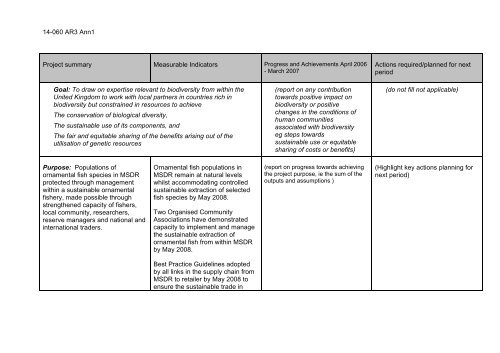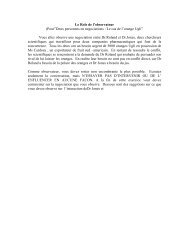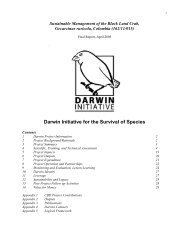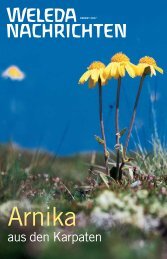14-060 AR3 Ann 1 - Logframe
14-060 AR3 Ann 1 - Logframe
14-060 AR3 Ann 1 - Logframe
You also want an ePaper? Increase the reach of your titles
YUMPU automatically turns print PDFs into web optimized ePapers that Google loves.
<strong>14</strong>-<strong>060</strong> <strong>AR3</strong> <strong>Ann</strong>1<br />
Project summary Measurable Indicators Progress and Achievements April 2006<br />
- March 2007<br />
Goal: To draw on expertise relevant to biodiversity from within the<br />
United Kingdom to work with local partners in countries rich in<br />
biodiversity but constrained in resources to achieve<br />
The conservation of biological diversity,<br />
The sustainable use of its components, and<br />
The fair and equitable sharing of the benefits arising out of the<br />
utilisation of genetic resources<br />
Purpose: Populations of<br />
ornamental fish species in MSDR<br />
protected through management<br />
within a sustainable ornamental<br />
fishery, made possible through<br />
strengthened capacity of fishers,<br />
local community, researchers,<br />
reserve managers and national and<br />
international traders.<br />
Ornamental fish populations in<br />
MSDR remain at natural levels<br />
whilst accommodating controlled<br />
sustainable extraction of selected<br />
fish species by May 2008.<br />
Two Organised Community<br />
Associations have demonstrated<br />
capacity to implement and manage<br />
the sustainable extraction of<br />
ornamental fish from within MSDR<br />
by May 2008.<br />
Best Practice Guidelines adopted<br />
by all links in the supply chain from<br />
MSDR to retailer by May 2008 to<br />
ensure the sustainable trade in<br />
(report on any contribution<br />
towards positive impact on<br />
biodiversity or positive<br />
changes in the conditions of<br />
human communities<br />
associated with biodiversity<br />
eg steps towards<br />
sustainable use or equitable<br />
sharing of costs or benefits)<br />
(report on progress towards achieving<br />
the project purpose, ie the sum of the<br />
outputs and assumptions )<br />
Actions required/planned for next<br />
period<br />
(do not fill not applicable)<br />
(Highlight key actions planning for<br />
next period)
<strong>14</strong>-<strong>060</strong> <strong>AR3</strong> <strong>Ann</strong>1<br />
Output 1. 1. Biodiversity of<br />
ornamental fish species in MSDR<br />
assessed, and a standardised,<br />
repeatable monitoring programme<br />
established.<br />
[Populations of ornamental fish in<br />
the MSDR are maintained at a<br />
natural level.]<br />
ornamental fish.<br />
1.1 MSDR ornamental fish<br />
population surveyed to document<br />
species present and population<br />
abundance within the designated<br />
fishing zones. The results written up<br />
and disseminated by May 2006.<br />
1.2 Ornamental fish stock<br />
monitoring protocol completed by<br />
August 06 for the Collection Area<br />
but which may be applied in a wider<br />
Amazon context.<br />
1.3 Collection Area Management<br />
Plan (CAMP) for ornamental fish<br />
extraction completed by April 2008<br />
to ensure its sustainable<br />
management.<br />
1.4 At least four biologists trained in<br />
scientific survey techniques to<br />
assess and monitor fish populations<br />
through three training courses run<br />
by Head Scientist on an annual<br />
basis commencing August 05.<br />
(report general progress and appropriateness of indicator)
<strong>14</strong>-<strong>060</strong> <strong>AR3</strong> <strong>Ann</strong>1<br />
Activity 1.1 insert activities relevant to this out put<br />
1.1.1 (T4) Biological survey protocol approved by August 05.<br />
1.1.2 (T13): Baseline fish surveys of the designated fishing zones<br />
completed and written up by June 06.<br />
1.1.3 (T19): Results of the baseline biological surveys presented to the<br />
communities by June 06.<br />
1.2.2 (T20): Biological monitoring protocol agreed and adopted by August<br />
06.<br />
1.3.1 (T31): CAMP content list drafted and agreed by December 2005.<br />
1.3.2 (T6): Supporting information for CAMP collected by project team by<br />
May 2006.<br />
1.3.3 (T27): Draft CAMP i completed and peer-review comments<br />
incorporated by June 07.<br />
1.4.1 (T29): Biological survey team trained to follow Collection Area<br />
monitoring protocol in June 2006 to commence survey work in July 2006.<br />
(report completed or progress on activities that contribute toward achieving this<br />
output), and what will be carried out in the next period
<strong>14</strong>-<strong>060</strong> <strong>AR3</strong> <strong>Ann</strong>1<br />
1.4.2 (T31): First annual Collection Area monitoring completed and written<br />
up by May 2007.<br />
1.4.3 (T36): This is to be repeated annually ad finitum.<br />
1.4.3 (T11): Biological survey team trained in survey techniques by HS<br />
July 2005, 2006 and 2007.<br />
Output 2. Social and economic<br />
parameters of community<br />
determined and monitored, local<br />
knowledge and needs identified,<br />
and feedback loop established.<br />
[Increase livelihood opportunities<br />
from extraction of sustainable levels<br />
of ornamental fish lead to increased<br />
income for households in MSDR].<br />
2.1 Households that have elected to<br />
be involved in the project benefit<br />
from an increased income of 10%<br />
due to the new fishery by 2008.<br />
2.2 Two Community Associations<br />
have the organisational capacity to<br />
effectively manage and monitor a<br />
sustainable trade in ornamental fish<br />
in MSDR by May 2008.<br />
Activity 2.1.1 (T5): Socioeconomic survey protocol agreed by September 05.<br />
2.1.2 (T7): Communities and individuals to be involved in the project<br />
determined and agreed by December 2005.<br />
2.1.3 (T<strong>14</strong>): Baseline socio-economic surveys of identified MSDM<br />
(report general progress and appropriateness of indicator)
<strong>14</strong>-<strong>060</strong> <strong>AR3</strong> <strong>Ann</strong>1<br />
communities and fishers completed by May 2006.<br />
2.1.4 (T21): Socio-economic monitoring protocol agreed by August 2006<br />
that will include indicators to measure the socio-economic impact of the<br />
trade in ornamental fish on the communities.<br />
2.2.1 (T12): Socio-economic survey team including community promoters<br />
trained in survey protocol by October 2005.<br />
2.2.2 (T19): Results of the baseline socio-economic surveys presented to<br />
the communities by June 06.<br />
2.2.3 (T22): Through a process of consultation, communities endorse Best<br />
Practice Guidelines ii by September 2006.<br />
2.2.4 (T26): Fishers trained in Best Practice Guidelines to be<br />
independently assessed as competent by May 2008<br />
2.2.5 (T24): Community organisations formed, officially registered and<br />
membership protocols agreed by September 2007.<br />
2.2.6 (T25): Training of designated personnel from community<br />
associations in business management, accounting reporting etc. to ensure<br />
that they are verified as competent by May 2008.<br />
Output 3. Market and economic<br />
potential for fishery identified, a<br />
business plan and standardised<br />
3.1 A sustainable trade in<br />
ornamental fish is established from<br />
the MSDR by May 2008.
<strong>14</strong>-<strong>060</strong> <strong>AR3</strong> <strong>Ann</strong>1<br />
guidelines in place for trading<br />
procedure from source to end-user.<br />
3.2 Standardised Best Practice<br />
Guidelines are adopted by May<br />
2008 for the sustainable trade in<br />
ornamental fish from MSDR that<br />
are transferable and can be applied<br />
in a wider Amazonian context.<br />
3.1.1 (T1): Industry analysis undertaken on UK and European fish trade<br />
with particular reference to Brazilian ornamental fish. Report produced by<br />
December 2005.<br />
3.1.2 (T9): Industry analysis undertaken on Brazilian fish trade with<br />
particular reference to fish exported from Manaus, Brazil, by December<br />
2005 to include current trade pathways/systems.<br />
3.1.3 (T10): Current and where possible future trade regulations identified<br />
by April 2006 to include taxes, custom requirements, health and welfare<br />
procedures in Brazil, UK, Europe, Japan and US.<br />
3.1.4 (T15): Business plan drafted and reviewed by project team by June<br />
2006 to include scenarios to advise selection of fish species list. T30:<br />
Business plan to be reviewed annually.<br />
3.1.5 (T28): Implementation of ornamental fish business plan by May<br />
2008.
<strong>14</strong>-<strong>060</strong> <strong>AR3</strong> <strong>Ann</strong>1<br />
3.2.1 (T2): Existing natural resource certification/guidelines are assessed<br />
and potential applicability determined by December 2005.<br />
3.2.2 (T32) Produce and peer review standardised Best Practice<br />
Guidelines for the sustainable trade in ornamental fish. Draft by June 2006<br />
and Final June 2007.<br />
3.2.3 (T40): Peer review standardised Best Practice Guidelines are<br />
adopted by fishers, managers, communities, traders, exporters, importers<br />
and retailers by May 2008<br />
3.2.4(T23): Procedures for trade documentation, verification of compliance<br />
to standards, auditing and feedback procedures developed and<br />
implemented by May 2008.<br />
Output 4 Fish welfare maintained<br />
from source to end user<br />
4.1 Ornamental fish welfare<br />
secured by achieving 80% reduced<br />
mortality along the supply chain<br />
from 2008.<br />
4.1.1 (T42). Recommendations for improved welfare by May 2006. Water quality<br />
parameter standards within defined optimum values achieved on 90% of shipments by<br />
May 2008.
<strong>14</strong>-<strong>060</strong> <strong>AR3</strong> <strong>Ann</strong>1<br />
4.1.2 (T32) Best practice guidelines produced for animal welfare from capture to consumer<br />
by May 2007.<br />
4.1.3 (T40) Communities, exporters and importers implementing Fish Welfare Best<br />
Practice guidelines by May 2008<br />
i CAMP to include: geographical, ownership and political boundaries of collection area, identification of all stakeholders, collection and fishing history, species for collection,<br />
catch quotas, monitoring protocol to include reporting of destructive or over fishing practices or list of significant organisms not to be touched and procedures in place to<br />
prevent this.<br />
ii Standardised guidelines are to include: ecosystem management which comprises the Collection Area Management Plan; collection methods, handling and storage; logistics<br />
and transportation from source to retailer which included husbandry and fish welfare; administrative and accounting procedures. To be defined further.







